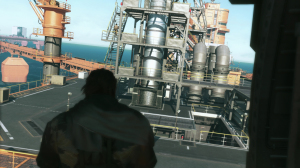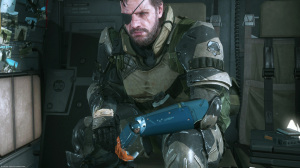After spending fourteen days straight with Metal Gear Solid V: The Phantom Pain, I can safely say it’s Hideo Kojima’s magnum opus. It’s quite simply the best game he’s ever done, plus the amount of freedom given to you throughout its entirety is absurd. If you’re a die hard fan of Metal Gear and are up to date with its timeline, Phantom Pain takes place during 1984 after the events of Metal Gear Solid V:Ground Zeroes (1975) and before the first Metal Gear (1995) on MSX. It has been 9 years since the tragic events in Ground Zeroes and Snake is a little worse for wear, having just woken up from his coma that nearly spanned a decade.
After a prologue that sets up the rest of the game Snake is rescued by his comrade and friend, Revolver Ocelot, before continuing his war path for vengeance and freeing his former partner Kazuhira Miller from the clutches of Soviet forces in Afghanistan. I’m not going to spoil the story or talk about the plot points (I agree with Kojima Productions’ wish to keep it a surprise), but I will say that there are twists and turns, and it ranks as one of the best tales in the series yet.
There’s no doubt that this is the largest and most accessible Metal Gear to date, full to the brim with content. But it’s not just a case of quantity over quality, every inch of the game is meticulously detailed, and has a vast amount of replay ability. It’s also incredibly fun, which always helps! The tone is vastly different to any other MGS game, as there are no more overly-long cut scenes and most of the detailed narration is dealt through cassette tapes, which you can listen to at your own pleasure. If you’ve played Ground Zeroes and think you know what to expect, I suggest you put that taster behind you and get ready to embark on a journey with no half-measures.
Unlike the confined spaces found during other entries in the series, MGS V consists of two enormous maps, Afghanistan and Africa, each of which house a plethora of side-ops and main missions; enabling you to explore and complete objectives in a dynamic and natural way. Each mission is structured like an episode from a TV show, operating in bite-sized chunks like if you were watching hit TV shows such as Breaking Bad and Sons Of Anarchy. Even if you’re in the middle of a mission that leads into the next with a tense cut scene, a small “to be continued” caption will appear, sending you back to your base of operations to prepare. It was a bit awkward for me, because 5 seconds later I’d simply continue, but if people need a break and want to gear up/upgrade sufficiently, it’s actually a very smart move.
Characters that will appear in this game:
Big Boss/Punished “Venom” Snake
Kazuhira Miller
Ocelot
Quiet
Skullface
Eli
Tretij Rebenok
Code Talker
Huey Emmerich
“Man on Fire”
There are more Characters and Groups that are in the game but I will not spoil the rest.
The variety of missions at hand will see you take out specific targets, gather Intel and garner more help. Funnily enough there isn’t a difficulty mode present, despite other titles encompassing tons of different options. Though I did find the gameplay pretty tough at certain points, it only made me want to upgrade further and try a different approach. Some people might get tired of a handful of repetitive missions, but I always had fun replaying them with a different tactic in mind. Being able to choose whether I operated during the night or day gave me a lot of flexibility, since enemy locations would alter depending on the time I chose.
Before setting off to fight it’s vital that you prep accordingly. Your Air Command Centre (ACC), gives you full control over all your upgrades and missions, tasking you to select which one you’d like to conduct first. As previously seen in Peace Walker, managing your Mother Base remains an integral part in Phantom Pain, allowing you to recruit staff and utilize resources for upgrades.
Acquiring items from the battlefield such as biological material and fuel canisters is incredibly important. These will allow you to develop extra platforms designed to boost your stats, including combat, R&D, support and medical. If you choose to focus on leveling up your R&D level and get the best Fulton, for example, you’ll then be able to extract entire containers of resources at a much earlier stage; reaping rewards much quicker and progressing more comfortably. You’ll also be able to extract vehicles as well, such as tanks or cars to take on missions.
Staff management is also key, and you can automatically or manually assign your comrades to the best departments. Despite being able to systematically place staff in their most skilled department, I decided to fully focus on R&D first, which let me take advantage of more advanced upgrades a lot sooner. It’s not always the best option, but just like any part of MGS V, it’s up to you to decide on how to proceed. Furthermore, you can send staff on their own missions to obtain more resources or extra recruits. Whilst I did get into the habit of sourcing soldiers with higher skill ratings (via upgrading my scope), I often attempted to extract anyone and everyone, in order to beef up my units and unlock upgrades at a quicker pace.
No matter what you try and accomplish, having the support of your army is always the heart of your experience. For instance, buddies can join you and aid your quest for vengeance in a multitude of ways. Bringing in a horse or bi-pedal Walker will allow you to traverse the environment more quickly – along with the other vehicles you’ve acquired as well. A dog can help distract your enemies or make you aware of their presence, and your comrade Quiet (who you can choose to kill or recruit) will aid you in combat, scout out maps and coordinate while dispatching enemies. Each aspect of a buddy’s armor and equipment can also be upgraded, such as changing Quiet’s cleavage with a little gold or silver paint. Lovely.
Your ACC can be used for mission briefs or organizing your army, but it also provides some vital support. As well as taking you in and out of missions, once on the ground you can also strategically place air strikes or smoke for cover, which can often be the life line you need in the midst of a firefight. There’s simply so much available to the player, no one will have the same experience. I constantly tested different ways to enter a mission, often resorting to complete stealth and learning from my many mistakes along the way.
After initially hearing about the absence of the veteran voice actor David Hayter in this game, it took me a while to move past the change in vocal chords. However, much like the constant change of actors playing Bond, I embraced the change and am now more than happy with Kiefer Sutherland’s portrayal. I have been an fan of him since the 24 TV show so I am used to hearing his voice and delivery of dialog. In fact, I believe Sutherland sounded more like an soldier than Hayter ever did. Exploring the beautiful vistas of Afghanistan is amazing, and the added jungle as you progress to Africa enhances the experience. The persistent image of a dusty wasteland is sometimes hard to muster. Having said that, the rest of the game’s extremely high quality means it doesn’t bother me. Now, where’s that remake of MGS 1 in Fox Engine?
With Kojima Productions’ impressive Fox Engine powering the entire experience, everything looks suitably crisp and clean, packaging in a tone of detail. Despite this being released on older hardware as well, I’m impressed with the core experience and I don’t think it has been hindered on more powerful consoles as a result. Then again, the fact that its design and graphical fidelity has had to cater to equipment with less power, it does make me wonder what could have been should Phantom Pain have released exclusively to PS4 and Xbox One, and not their older siblings.
To me, Robin Atkin Downes as Kaz Miller was more enjoyable in this game than he was in Peace Walker and Ground Zeroes. His anger really shows during the cut scenes. I would be mad at the world if I lost my leg and arm so I understand why. Troy Baker as Ocelot to me, was his best voice acting in any video game since Snow from Final Fantasy XIII. And James Horan as Skullface not only delivered an great and believable performance as an villain, but also made the player wanted to take him down for good. I can call him the Joker of the Metal Gear series since his and Big Boss’ upbringings kind of parallel each other.
Conclusion
Phantom Pain presents the most flexible gameplay in the series to date, and fills in unseen moments from the Metal Gear saga with style. I strongly suggest you pick this up and experiment with your own strategies, as you’re presented with endless possibilities. Grab your cardboard box, the world needs saving!
follow me on twitter @julianexcalibur







